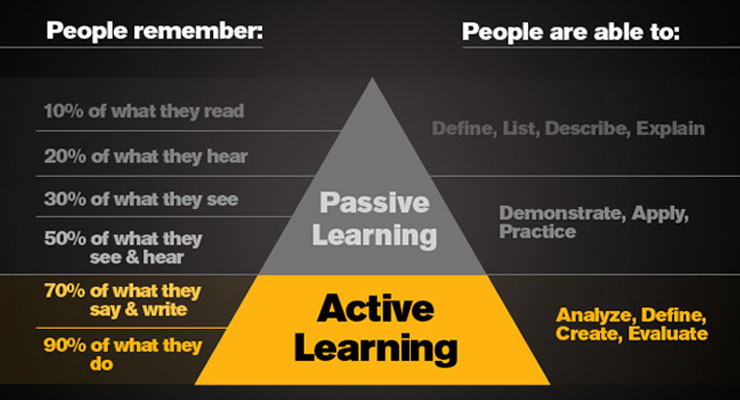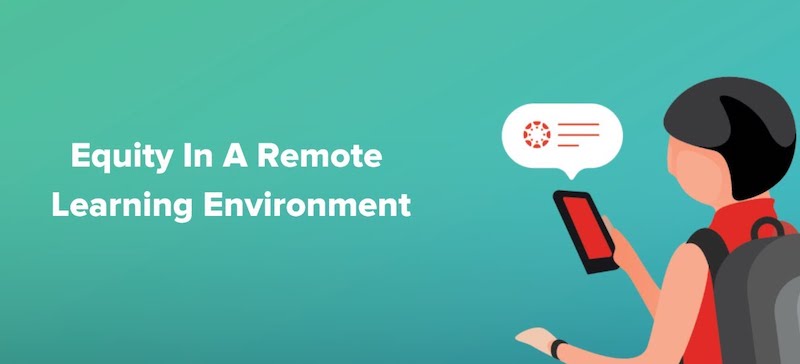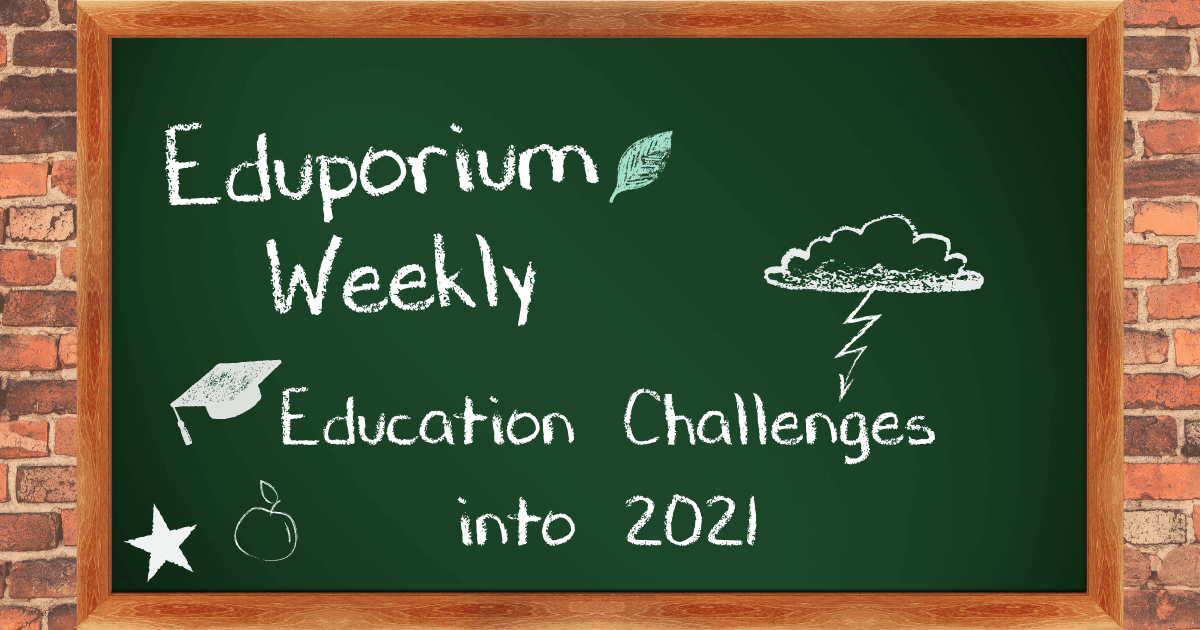The changes at all levels of education this year have taught us a lot. We’ve learned that everything can be upended at any moment, that equitable access to technology is far from universal, that teachers worked harder than ever, and that snow days might be a thing of the past. All the insights we’ve gained throughout the pandemic are lessons most of us wouldn’t have thought we’d need to learn but they have become very valuable. Now, education leaders are trying to carry over these insights and researching how to apply them in the future. So, as we say goodbye to 2020, these are some of the biggest topics and issues for 2021.
Passive Learning
We wouldn’t have gotten far without technology to help educators modify teaching and learning. For those students who have reliable Internet access and a device, they’re more than likely doing as well as anybody could have expected given the circumstances surrounding distance learning. In fact, some kids are thriving in remote learning due to fewer distractions or moving through lessons at their own speed. Although these cases are in the minority, it still provides educators with valuable information that they otherwise would not know. At the same time, however, most kids must sit still all by themselves and stare at screens all day and we know that this is far from ideal.
Two big downsides to continuing learning remotely are it's isolated and minimal. Students, understandably, don't always receive engaging and interactive learning experiences that they'd get in their classrooms with their classmates. This can limit opportunities they have to bolster valuable soft skills, like collaboration and communication, and often results in them feeling more isolated and anxious about the situation. Also, while some students thrive in individual work, other ones are more likely to thrive within a social setting, whether that’s made up largely of collaborative or individual assignments. Watching videos and writing answers can only do so much for students who'd much rather be learning actively than passively.
Of course, children need socialization in their education in order to develop core SEL competencies. Some also tend to struggle with sitting still, which active learning activities can help combat, but that isn't always the case anymore. Now, many of them must sit still, watch a video, complete online activities, click through slides, or read documents online—something that's not very exciting. These are each certainly examples of passive learning and can make it hard on students to just sit and listen. It is almost impossible for some of these kids to engage with the content and stay engaged throughout the day. Plus, for children who already showed signs of needing active experiences, not getting them can result in stunted progress as just one of the additional factors to consider.

Educator Burnout
By now, everyone has likely heard how teachers are simply worn out amid remote instruction. This includes both a physical lack of energy and a mental lack of knowing when the end is in sight. Not to mention, many are working two or three times as hard as they would in normal circumstances, including learning how they should incorporate technology. Even with months of remote teaching under their belts, practice with doing the almost impossible isn’t going to help most educators with enormous amounts of work, including lesson design, setting up meetings, grading, providing useful feedback and, in some cases, creating personalized or individual education plans for different students. It’s something they clearly didn’t sign up for and, at this rate, it’s looking fairly bleak.
Besides preparing to teach every student and provide them with what they need, there’s also the prospect of navigating the huge sea of educational resources. It’s been a common complaint since distance learning began, but educators don’t need more digital resources thrown at them. Different resources aren't effective for everyone and teachers certainly don’t need to take time learning to use things so often. Filtering out the resources they don’t find helpful also takes up time and the simple thought of having to do so is enough for many of them to experience anxiety or frustration. So, pair the already high amounts of physical exhaustion with mental challenges and that doesn’t sound like a good recipe.
We also must remember that educators are experiencing many of the same non-academic anxieties as the rest of us. The state of educator mental health is always changing—improving some days while declining on others. They could be facing some of the same social and emotional issues their students have faced, including struggles with isolation, the loss of a family member, or worry about if they’ll even ultimately keep their jobs. They don’t need the additional stress of parents or random people telling them that they need to work harder. Plus, they might have their own kids in distance learning and trying to balance educating them with their own teaching. It’s a whole lot to consider and so many people don’t even realize the half of it.
Student Safety, Protection, and Production
This might seem obvious but there are so many layers that go into ensuring every student remains safe. Of course, the first thing we think of today is physical safety and keeping them from catching the Coronavirus. That alone takes a village but it’s just one of three central elements of keeping students safe these days. In addition to their physical safety, educators and parents must now also consider their emotional safety and digital safety. Since they’re spending so much time online and staring at screens on or offline, it’s fair to be wondering what effects that has on their physical health. It can also affect both their mental and emotional health as can the isolation from their friends. Then, there’s the student digital wellbeing side and ensuring both their mental health and personal information remain intact. So, yes, there’s quite a lot to it.
While digital citizenship is important, it’s tough for educators to find the time and resources for teaching it remotely. Plus, not all the digital wellbeing responsibility falls on students since school and district leaders often select virtual learning platforms and programs for them to use. God forbid some of these programs end up becoming compromised and there could be more serious issues. This can affect kids directly or not but it’s a reminder to carefully vet all tools for potential security issues. It’s often easier on school leaders to protect children when they’re actually in school buildings—both physically and digitally but, once they log in remotely, they could be more vulnerable. And, that’s something that district leaders and IT professionals must now keep in mind as remote learning continues.
As for production, many students rely on various EdTech tools for all or most of their learning. This includes exploring new concepts, homework, and tests. This huge reliance on technology, including various learning platforms and good Internet access, is not always guaranteed and, more importantly, it’s no guarantee that educators will be able to mesh it with the learning styles and preferences of each student. Teachers must keep in mind that EdTech-enabled learning might not be for all students and may show drops in academic performance. It may also, however, allow them to develop other important soft skills, like problem-solving abilities, adaptation, and even communication. And, student productivity and achievement throughout the remote learning period isn't based on test scores, so, as long as they’re progressing, it can still be a ‘win.’

Gaps in Equity and Student Progress
Hopefully, when the 2020-21 school year concludes, students will have spent a good amount of time in the classroom. As we know, however, the prospects of returns to in-person education full time aren’t promising right now and, as part of the academic and social challenges this might create, gaps in what every kid can achieve in terms of intellectual growth are bound to appear. There are a few different things that contribute to students being unable to build new knowledge and skills while learning remotely, including many missed opportunities for individualized instruction and unreliable access to the Internet. This is perhaps the biggest reason some students slip behind with this inequity also creating bigger gaps in development.
For students who are now part of remote or hybrid models, there are two critical pieces to ensure they can effectively continue their education: a device and an Internet connection. The pandemic has taught us that not every student has both of these things. Some live in rural areas without high-speed Internet, especially for streaming video lessons and virtual meetings. Others live in poorer places or simply cannot afford this luxury. This, then, leaves those students on the outside looking in or forces teachers to create alternatives for them. It could also mean printing worksheets and reading materials for kids to complete, which is not ideal for anybody. This lack of equity in distance learning has disproportionately affected students who were already disadvantaged and we can't do much.
If distance learning continues long-term, which looks likely, school and district leaders must find some way to connect every student. This might involve working with leaders at tech companies or perhaps politicians to help improve the experiences of their students. Teachers already have a ton on their plates and creating, printing, and delivering learning resources to students who can’t access them isn't ideal, though many are still willing to do this so that students have some way to learn. What it comes down to is realizing just how far away we are from ensuring every student is connected. The pandemic has shone a much brighter light on this but, since remote learning will continue, we need something substantial. Making learning resources available on every device is a good start but that still might not be enough.
Turning Challenges Into Opportunities
The good news is that, after months of remote education, students and teachers learned a lot about what's worked. Like we've said, there's no clear end to distance learning, so using what we’ve learned is the next best thing. Take blended learning, for example. Combining face-to-face and video instruction can be useful for some students and can be a time saver for some teachers. This would also free up time for teachers to spend working with kids who might be struggling more than others. If nothing else, it creates opportunities to change things up so students can do something different. As remote learning continues on, it’s definitely possible that teachers may rely more on blended learning. This means kids could do lessons on their own—especially students in upper elementary, middle, and high school.
One other challenge educators have faced is making up for the lost in-person connections they’ve always had with their students. One idea is recreating them with one-on-one virtual meetings but that's not always successful. Home visits aren’t ideal, so one-on-one virtual meetings and hoping for returns to school might be best for building relationships. Switching gears, as remote learning draws on, virtual learning resources have evolved and are more readily available. Curated teaching tools, including educational content, virtual coding platforms, and video libraries can help create a new experience. As long as it’s not overwhelming for teachers, it definitely seems more organized than when remote education began.
Teachers already would learn from each other before the pandemic but many have found increased value in collaboration since then. Whether it’s simple conversations about online resources or attending remote learning webinars together, collaborating helps educators improve teaching tactics. Finally, all education professionals have developed greater empathy for when they return to the classroom and re-connect with students. Many will have new respect for their peers, better understanding of their students, or a renewed outlook on social connections. While we’ve learned a lot about education this year, we’re also hoping that things return to normal soon. But, in the meantime, hopefully we can all continue getting by.
For the latest EdTech, STEM, and 21st century education news, follow us on Twitter and Instagram. Like us on Facebook, too, or sign up for our newsletter for our latest product announcements and offerings. If you have an idea for an Eduporium Weekly theme, send us a message on social media or comment below. Also, check out the Remote and Hybrid Learning section of our store for versatile STEM tools.



